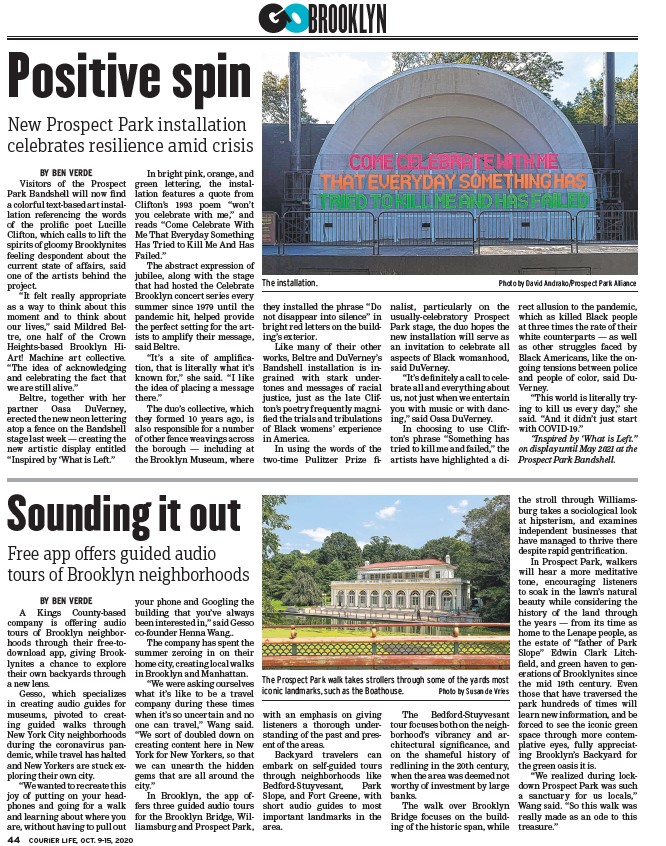
New Prospect Park installation
celebrates resilience amid crisis
BY BEN VERDE
Visitors of the Prospect
Park Bandshell will now fi nd
a colorful text-based art installation
referencing the words
of the prolifi c poet Lucille
Clifton, which calls to lift the
spirits of gloomy Brooklynites
feeling despondent about the
current state of affairs, said
one of the artists behind the
project.
“It felt really appropriate
as a way to think about this
moment and to think about
our lives,” said Mildred Beltre,
one half of the Crown
Heights-based Brooklyn Hi-
Art! Machine art collective.
“The idea of acknowledging
and celebrating the fact that
we are still alive.”
Beltre, together with her
partner Oasa DuVerney,
erected the new neon lettering
atop a fence on the Bandshell
stage last week — creating the
new artistic display entitled
“Inspired by ‘What is Left.”
COURIER L 44 IFE, OCT. 9-15, 2020
In bright pink, orange, and
green lettering, the installation
features a quote from
Clifton’s 1993 poem “won’t
you celebrate with me,” and
reads “Come Celebrate With
Me That Everyday Something
Has Tried to Kill Me And Has
Failed.”
The abstract expression of
jubilee, along with the stage
that had hosted the Celebrate
Brooklyn concert series every
summer since 1979 until the
pandemic hit, helped provide
the perfect setting for the artists
to amplify their message,
said Beltre.
“It’s a site of amplifi cation,
that is literally what it’s
known for,” she said. “I like
the idea of placing a message
there.”
The duo’s collective, which
they formed 10 years ago, is
also responsible for a number
of other fence weavings across
the borough — including at
the Brooklyn Museum, where
they installed the phrase “Do
not disappear into silence” in
bright red letters on the building’s
exterior.
Like many of their other
works, Beltre and DuVerney’s
Bandshell installation is ingrained
with stark undertones
and messages of racial
justice, just as the late Clifton’s
poetry frequently magnifi
ed the trials and tribulations
of Black womens’ experience
in America.
In using the words of the
two-time Pulitzer Prize fi -
nalist, particularly on the
usually-celebratory Prospect
Park stage, the duo hopes the
new installation will serve as
an invitation to celebrate all
aspects of Black womanhood,
said DuVerney.
“It’s defi nitely a call to celebrate
all and everything about
us, not just when we entertain
you with music or with dancing,”
said Oasa DuVerney.
In choosing to use Clifrton’s
phrase “Something has
tried to kill me and failed,” the
artists have highlighted a direct
allusion to the pandemic,
which as killed Black people
at three times the rate of their
white counterparts — as well
as other struggles faced by
Black Americans, like the ongoing
tensions between police
and people of color, said Du-
Verney.
“This world is literally trying
to kill us every day,” she
said. “And it didn’t just start
with COVID-19.”
“Inspired by ‘What is Left.”
on display until May 2021 at the
Prospect Park Bandshell.
BY BEN VERDE
A Kings County-based
company is offering audio
tours of Brooklyn neighborhoods
through their free-todownload
app, giving Brooklynites
a chance to explore
their own backyards through
a new lens.
Gesso, which specializes
in creating audio guides for
museums, pivoted to creating
guided walks through
New York City neighborhoods
during the coronavirus pandemic,
while travel has halted
and New Yorkers are stuck exploring
their own city.
“We wanted to recreate this
joy of putting on your headphones
and going for a walk
and learning about where you
are, without having to pull out
your phone and Googling the
building that you’ve always
been interested in,” said Gesso
co-founder Henna Wang..
The company has spent the
summer zeroing in on their
home city, creating local walks
in Brooklyn and Manhattan.
“We were asking ourselves
what it’s like to be a travel
company during these times
when it’s so uncertain and no
one can travel,” Wang said.
“We sort of doubled down on
creating content here in New
York for New Yorkers, so that
we can unearth the hidden
gems that are all around the
city.”
In Brooklyn, the app offers
three guided audio tours
for the Brooklyn Bridge, Williamsburg
and Prospect Park,
with an emphasis on giving
listeners a thorough understanding
of the past and present
of the areas.
Backyard travelers can
embark on self-guided tours
through neighborhoods like
Bedford-Stuyvesant, Park
Slope, and Fort Greene, with
short audio guides to most
important landmarks in the
area.
The Bedford-Stuyvesant
tour focuses both on the neighborhood’s
vibrancy and architectural
signifi cance, and
on the shameful history of
redlining in the 20th century,
when the area was deemed not
worthy of investment by large
banks.
The walk over Brooklyn
Bridge focuses on the building
of the historic span, while
the stroll through Williamsburg
takes a sociological look
at hipsterism, and examines
independent businesses that
have managed to thrive there
despite rapid gentrifi cation.
In Prospect Park, walkers
will hear a more meditative
tone, encouraging listeners
to soak in the lawn’s natural
beauty while considering the
history of the land through
the years — from its time as
home to the Lenape people, as
the estate of “father of Park
Slope” Edwin Clark Litchfi
eld, and green haven to generations
of Brooklynites since
the mid 19th century. Even
those that have traversed the
park hundreds of times will
learn new information, and be
forced to see the iconic green
space through more contemplative
eyes, fully appreciating
Brooklyn’s Backyard for
the green oasis it is.
“We realized during lockdown
Prospect Park was such
a sanctuary for us locals,”
Wang said. “So this walk was
really made as an ode to this
treasure.”
Positive spin
Free app off ers guided audio
tours of Brooklyn neighborhoods
BROOKLYN
Sounding it out
The installation. Photo by David Andrako/Prospect Park Alliance
The Prospect Park walk takes strollers through some of the yards most
iconic landmarks, such as the Boathouse. Photo by Susan de Vries